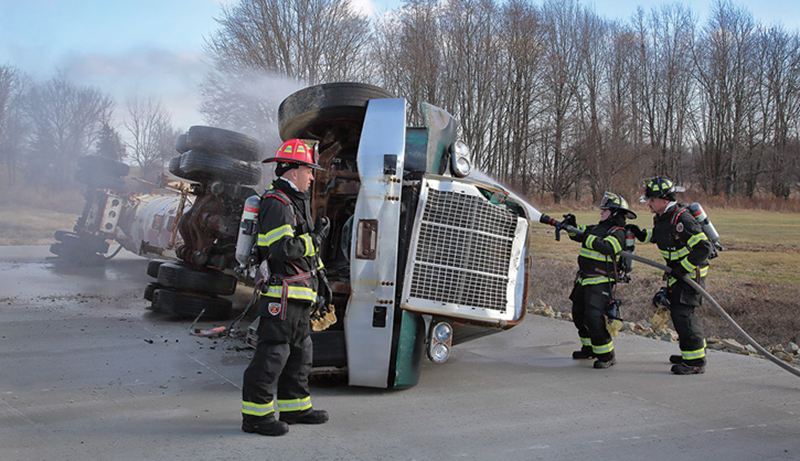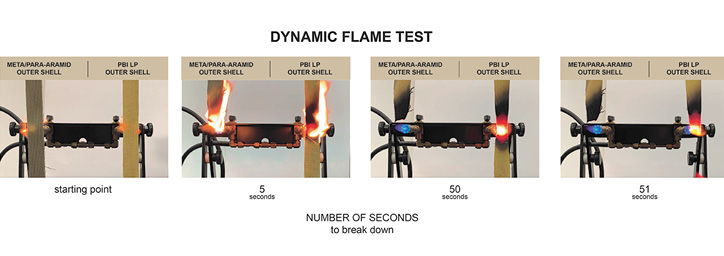Personal protective equipment (PPE) manufacturers and the makers of the fabrics and fibers that go into them continue to turn out new and improved designs and products that give added protection, comfort, and durability for firefighters.
Derrick Mitsch, product line manager of turnout gear and boots for MSA Safety, says MSA/Globe’s ATHLETIX™ turnout gear is designed with firefighter ergonomics in mind. “We focus on a fit that makes the ensemble easier to wear with the jacket and pants designed with the shape of the individual body in mind so that the garments move easily with the body,” Mitsch says.
He notes that the ATHLETIX jacket has a streamlined design with vertical seaming to reduce oversize in the front of the chest and under the self-contained breathing apparatus (SCBA) and also to give a stiffness in the front closure. The jacket incorporates a YOCCO™ drag rescue device, has a liner access opening for access between the layers, and has more flexible seams safety-stitched and double-needle top-stitched for strength with less bulkiness yet lay flat. Mitsch says the jacket has a softer, more adjustable collar; elasticized side panels for an athletic fit at the waist; articulated elbows; and cargo pockets with grip tabs for quicker and easier opening.
ATHLETIX pants have an adjustable belt closure to make the pants fit like jeans, Mitsch points out, which can be replaced by a Class 2 seat harness or personal escape belt. The pants have a reverse boot cut shorter in the back to prevent premature cuff wear; more flexible seams, like the jacket; a low-rise, less bulky design; stretch panels in the thermal barrier and outer shell; a banded inseam design to reduce binding in the crotch; articulated knees; elasticized sides at the waist; and angled side pockets with grip tabs.
Jason Traynor, MSA’s general manager of global fire service products, says MSA is looking to produce an entire PPE ensemble for firefighters, with turnouts, helmets, boots, hoods, and SCBA among its products. “We are designing a system for the end user to complement how the turnouts interconnect with the SCBA, how the hood interacts with the face piece or friction pads on the shoulders, what the total heat stress is on the individual, and eliminating physical burdens of too much weight on the back and the head.”
Todd Herring, vice president of innovation and strategy for Fire-Dex, says his company has focused a great deal on heat stress mitigation. “A lot of that development depends on the materials,” Herring points out, “and we are working toward the next generation of materials that will impact weight and breathability of turnout gear.” He notes that total heat loss (THL) has been a standard measurement for the physiological impact on firefighters, but in certain situations, it might be more indicative to focus on the body evaporation of perspiration. “RET or resistance evaporative transfer is a measure of the resistance to evaporation,” Herring says. “It’s similar to the THL test but RET simulates hotter conditions better and helps us design a better turnout gear product.”

1 MSA Safety/Globe’s ATHLETIX™ turnout jacket has a streamlined design with vertical seaming to reduce oversize in the front of the chest and under the SCBA. (Photos 1-2 courtesy of MSA Safety/Globe.)

2 MSA/Globe’s ATHLETIX turnout pants have an adjustable belt closure, a reverse boot cut cuff, flexible seams, and a banded inseam to reduce binding.

3 Fire-Dex’s FXR custom turnout gear uses a TECGEN 71 6.5-ounce outer shell constructed in an Active Posture Design™ to allow a full range of motion and reduce stress and fatigue. (Photos 3-4 courtesy of Fire-Dex.)

4 FXR turnout gear by Fire-Dex has a jacket with a seamless collar with DexFlex natural curve elbows and pants with DexCuff to reduce materials that rub on the ground, with DexFlex knees, which are pre-bent to increase natural movement.

5 LION makes several models of turnout gear, including RedZone™, which is designed to use lighter weight fabrics that reduce firefighter heat stress while providing comfort, safety, and mobility. (Photos 5-6 courtesy of Lion.)

6 LION has developed new shell and liner interfaces on its turnout gear, like where the shell and liner interface on the coat’s cuffs (shown) and in the fly area of the pants.
Herring notes that Fire-Dex’s TECGEN 71 is a 6.5-ounce outer shell used in Fire-Dex’s FXR custom turnouts designed to minimize firefighter stress and fatigue through Active Posture Design™, which allows for a full range of motion. He says FXR turnouts have a seamless collar on the jacket, DexFlex elbows where pleats curve the sleeve to an arm’s natural bend without restricting movement, an OmniDex™ shoulder to eliminate coat rise and sleeve retraction, a comfort pant inseam that reduces bulk and wear and tear with a seamless gusset, DexCuff that reduces cuff materials that drag or rub against the ground, and DexFlex knees that are pre-bent to increase natural movement.
Alysha Gray, product marketing director for LION, says LION recently launched new shell and liner interfaces on its turnout gear. “Hook and loop durability is a big issue, especially with firefighters washing their gear more than ever before,” Gray says. “With our new interfaces, we removed the hook and loop and replace it with a zipper in the collar where the shell and liner interface, on the cuffs of the coat, and in the fly area of the pants. We’ve also introduced magnet closures on pockets and storm flaps and now use an enhanced stitch pattern that uses ultrasonic vibratory waves to fuse the edges of the fabrics.”

7 Veridian Fire Protective Gear’s line of turnout gear includes Velocity, an ergonomic design engineered to give firefighters a full range of motion. (Photos 7-8 courtesy of Veridian.)

8 Veridian Fire Protective Gear makes the Ultra Flex knee on all its turnout pants with a diamond flex padded form-fitted knee.

9 PBI Performance Products makes PBI LP™ fiber that last more than 50 seconds under dynamic flame. (Photo 9 courtesy of PBI Performance Products.)
Karen Lehtonen, vice president of innovation and product development for LION, says LION makes the V-Force®, RedZone™, Super-Deluxe™, Traditional, LIONExpress™, and Reliant™ models of turnout gear. “Our philosophy to have the gear work with the firefighters and not against them, that provides comfort, safety, and mobility.” She adds that through the use of lighter weight fabrics, LION is able to reduce firefighter heat stress, which she says is still is the number one cause of fatalities in firefighters. “But cancer and particulate contaminants are big concerns too, so we have to balance protection from contaminants and still maintain high levels of breathability in the turnout gear.”
Gray points out that LION’s turnout gear blocks particulate contamination in interface areas by using DuPont’s™ Nomex® Nano Flex fabrics in combination with LION’s liner system. She says that in the wristlet LION uses a layer of Nano Flex in conjunction with their moisture barrier and also in the bottom of the pant in the calf guard to go over the boot as well as in LION’s Core Guard, an elastic from the coat that overlaps the top of the pant.
Doug Dafler, director of sales for Veridian Fire Protective Gear, says his company has moved to the PF3 waterproof treatment on outer shells and other components to get away from prior use of harsh polyfluoroalkyl substances (PFAS) chemicals. “We also have a unique way of handling the knees on turnout pants,” Dafler notes. “We make a diamond flex padded and form-fitted knee where the cushioning is a FR (fire resistant) closed-cell foam enclosed in a polymer-coated Kevlar exterior material, which we also use on cuffs and other reinforcement areas.”
Dafler notes that Veridian’s line of turnout gear includes Velocity, an ergonomic design engineered to give firefighters a full range of motion. Besides the Ultra Flex Knee, the pants are triple pleated for extra comfort, and the coat has an Ultra FlexWing Expanded back for a bind-free reach, he says, and a FlexElbow that adds outer shell pleats combined with liner darts to give a natural contour at the elbow while complementing the integrated seamless underarm bellows.
Veridian also makes the Vanguard model of turnout gear that has the FlexWing Expanded Back, pleated FlexElbows, and pleated FlexKnees, with a short style coat and a high back trouser for a light combination of gear, Dafler says. Veridian’s Valor turnout gear combines traditional fit with ergonomic design with a FlexWing Expanded Back, pleated FlexElbows, and pleated FlexKnees.
Eric Baker, director of sales for Lakeland Industries, notes that Lakeland is focused on making its turnout gear more ergonomic, comfortable, and safer for firefighters while using less material to cut weight. “Using less material also allows the firefighter to move more easily in the gear but still have a very strong level of protection,” Baker points out.
“The sleeves of our Stealth turnout coat are contoured with a bent elbow to allow the arm to move without resistance, and dynamic pleats in the knees of the pants give more mobility when bending down or squatting,” he says. “We want to make our gear as comfortable as possible while eliminating as much fatigue as we can and reducing heat stress on the firefighter.” Baker points out the Stealth coat features LazerMax reflective trim and an easy-grip drag rescue device, while the Stealth turnout pants also have LazerMax reflective piping, a beveled waist design, double-layer padded knees, and no side seams exposed to abrasion. Lakeland also makes the B2 style pleated turnout coat and pants that include some of the Stealth’s features.
Bryan Bolden, senior director of sales and marketing for the Americas for PBI Performance Products, notes that PBI makes PBI LP™ fiber, which he says raises the bar on flame resistance and break open protection. Bolden adds that as fabrics get lighter in weight to address firefighter heat stress issues, they run the risk of compromising flame resistance and break open protection.
However, he says, “PBI LP actually increases flame resistance and break open protection. A traditional heavier weight outer shell not containing PBI breaks down after four to five seconds of dynamic flame exposure, but an outer shell made from PBI LP fiber lasts more than 50 seconds under dynamic flame, giving unmatched flame protection.”

10 Safety Components makes the PBI Max™ LP outer shell fabric in a 6-ounce weight. (Photos 10-11 courtesy of Safety Components.)

11 Safety Components’ Armor AP™ outer shell fabric is 80 percent meta/para-aramid spun yarns and 20 percent DuPont™ Kevlar® filament.
Bill Black, western region sales manager for Safety Components, calls his company’s PBI Max™ LP outer shell fabric “a game changer” in reducing the weight to 6 ounces from the 7-ounce weight of its traditional PBI Max fabric. “PBI Max LP’s lightweight design doesn’t mean light duty,” Black points out. “We incorporate 30 percent DuPont™ Kevlar® filament with 70 percent PBI LP para-aramid spun yarns in our Filament Twill Technology™ to give increased tear resistance and greater break open protection after exposure to flame.”
Black notes that Safety Components also makes the Armor AP™ outer shell fabric in a 6.5-ounce weight, “for firefighters who prefer improved mobility, improved durability, and improved protection at an economical price.” He adds that Armor AP is made with Filament Twill Technology of 80 percent meta/para-aramid spun yarns and 20 percent 400 denier DuPont Kevlar filament. Safety Components also makes a Glide Ice™ thermal liner, constructed of 60 percent DuPont Nomex® filament yarns and 40 percent DuPont Nomex/Lenzing FR® spun yards to offer firefighters comfort, freedom of movement, and optimal moisture management.
ALAN M. PETRILLO is a Tucson, Arizona-based journalist, the author of three novels and five nonfiction books, and a member of the Fire Apparatus & Emergency Equipment Editorial Advisory Board. He served 22 years with the Verdoy (NY) Fire Department, including in the position of chief.

